Life Force: The Source of Self-Regulation, Love and Bonding1
The Therapeutic Functions It Underlies
Guy Tonella
Bioenergetic Analysis • The Clinical Journal of the IIBA, 2020 (30), 59–74
https://doi.org/10.30820/0743-4804-2020-30-59 CC BY-NC-ND 4.0 www.bioenergetic-analysis.com
Abstracts
“Life force” is at the core of the prodigious upsurge in the complexification of the living, from the bacterium to the human being, thanks to the life force’s regulating principle: “homeostasis”. Lowen had faith in the life force, in the unsuspecting skills of the human organism, in his intelligence, in his capacities of self-regulation. We, bioenergetic therapists, are today “ferrymen” between the atom and the spirit, “ferrymen” between nature and culture, “ferrymen” between individual homeostasis and ecological homeostasis, “ferrymen” between the grounding in the earth and the oceanic feeling. We transmit to our patients these bonds of attachment that unite us both to humanity and to nature: these links are sensori-emotional in nature, intrinsically intelligent and deeply regulating.
Key words: life force, regulatory homeostasis, ESMER functions, therapist’ functions
La force vitale: La source d’autorégulation, d’amour et d’attachement. Les fonctions thérapeutiques que cela sous-tend (French)
La “force vitale” est au cœur de la prodigieuse recrudescence de la complexification du vivant, de la bactérie à l’être humain, grâce à son principe régulateur: “l’homéostasie”. Lowen avait foi dans la force vitale, dans les compétences innées de l’organisme humain, dans son intelligence, dans ses capacités d’autorégulation. Nous, thérapeutes bioénergétiques, sommes aujourd’hui des passeurs entre l’atome et l’esprit, des passeurs entre nature et culture, des passeurs entre l’homéostasie individuelle et l’homéostasie écologique et systémique, des passeurs entre l’enracinement dans la terre et le sentiment océanique. Nous transmettons à nos patients ces liens d’attachement qui nous unissent à la fois à l’humanité et à la nature: ces liens sont de nature sensori-émotionnelle, intrinsèquement intelligent et profondément régulateurs.
Fuerza vital: La fuente de la autoregulacion, Amor e Union. Funciones terapeuticas que subyacen (Spanish)
La “fuerza vital” está en el centro del prodigioso aumento de la complejidad de los vivos, desde la bacteria hasta el ser humano, gracias al principio regulador de la: “homeostasis”. Lowen tenía fe en la fuerza vital, en las habilidades desprevenidas del organismo humano, en su inteligencia, en sus capacidades de autorregulación. Nosotros, terapeutas bioenergéticos, somos hoy “barqueros” entre el átomo y el espíritu, “barqueros” entre la naturaleza y la cultura, “barqueros” entre la homeostasis individual y la homeostasis ecológica, “barqueros” entre la tierra y la sensación oceánica. Transmitimos a nuestros pacientes estos lazos de apego que nos unen tanto a la humanidad como a la naturaleza: estos vínculos son de naturaleza sensorio-emocional, intrínsecamente inteligentes y profundamente reguladores.
Forza vitale: fonte dell’autoregolazione, dell’amore e del legame. Le funzioni terapeutiche sottostanti (Italian)
La “forza vitale” è il fulcro dell’impulso prodigioso della complessità della vita, dal batterio all’essere umano, grazie al principio regolatore della forza vitale: “l’omeostasi”. Lowen aveva fede nella forza della vita, nelle insospettabili capacità dell’organismo umano, nella sua intelligenza, nelle sue capacità di autoregolazione. Noi terapeuti bioenergetici, oggi siamo “traghettatori” tra la l’atomo e lo spirito, “traghettatori” tra cultura e natura, “traghettatori” tra omeostasi individuale e omeostasi ecologica, “traghettatori” tra il radicamento nella terra e il sentimento oceanico. Trasmettiamo ai nostri pazienti questi legami di attaccamento che ci uniscono sia all’umanità che alla natura: questi legami sono di natura sensoriale-emotiva, intrinsecamente intelligenti e profondamente regolatori.
Força Vital: A Fonte da Autorregulação, Amor e Vínculo. As Funções Terapêuticas em que se baseia (Portuguese)
A “força vital” está no centro do extraordinário aumento na complexificação da vida, da bactéria ao ser humano, graças ao princípio regulador da força vital: a “homeostase”. Lowen tinha fé na força vital, nas habilidades insuspeitadas do organismo humano, em sua inteligência e em sua capacidade de autorregulação. Hoje, nós, terapeutas bioenergéticos, somos “mensageiros” entre o átomo e o espírito, entre a natureza e a cultura, “mensageiros” entre a homeostase individual e a ecológica, entre o “grounding” na terra e o sentimento oceânico. Transmitimos aos nossos clientes esses vínculos de apego que nos unem à humanidade e à natureza: essas conexões são de caráter sensório-emocional, intrinsecamente inteligentes e profundamente reguladoras.
Lebenskraft: Die Quelle der Selbst-Regulation, Liebe und Bindung. Die therapeutische Funktion, der sie unterliegt (German)
“Lebenskraft” ist im ‘Kern’ des erstaunlichen Auftriebs in der Komplexifizierung des Lebens, vom Bakterium bis zum Menschen, dank des die Lebenskraft regulierenden Prinzips: der “Homöostase”. Lowen glaubte an die Lebenskraft, an die arglosen Fähigkeiten des menschlichen Organismus’, an seine Intelligenz, an seine Möglichkeiten der Selbstregulation. Wir, bioenergetischen Therapeut_innen, sind heutzutage “Fährleute” zwischen dem Atom und dem Geist, zwischen Natur und Kultur, zwischen individueller und ökologischer Homöostasis, zwischen Erdung und ozeanischen Gefühlen. Wir übertragen unseren Klient_innen diese bonds of attachment, die uns vereinen sowohl mit der Menschlichkeit und der Natur: diese Verbindungen sind natürlicherweise sensorisch-emotional, intrinsisch intelligent und zu tiefst regulierend.
Жизненная сила: источник саморегуляции, любви и бондинга. Терапевтические функции в её основе (Ги Тонелла) (Russian)
“Жизненная сила” лежит в основе поразительного роста уровня усложнения жизни, от бактерий до человека, благодаря регулирующему принципу жизненной силы: “гомеостазу”. Лоуэн верил в жизненную силу, в навыки человеческого организма, о которых мы еще не догадываемся, в его разум, в его способности саморегуляции. Мы, биоэнергетические терапевты, являемся “паромщиками” современности, соединяющими атом и дух; “паромщиками”, соединяющими природу и культуру; “паромщиками”, соединяющими гомеостаз отдельного человека и гомеостаз экологии; “паромщиками”, соединяющими заземление в земле и ощущение “растворения в океане”. Мы транслируем нашим пациентам эти связи, которые объединяют нас как с человечеством, так и с природой: эти связи являются сенсорно-эмоциональными по своей природе, разумными и глубинно-регулирующими по своей сути.
The Origin of The Force
The Big Bang brought about the formation of our planets. One of these, planet Earth, was shaped over 4600 million years ago. Star dust that carries this imprint forever, is evident in the physical-chemical composition of our celestial body: minerals originating from the universe’s compositional material, all types of atmospheric gases (oxygen amongst others) and proteins, carbohydrates and lipids from the fruits of nature that developed on Earth. Our tubular physiology (respiratory, digestive, neural and blood tubes) is an endless fractal tree that resembles that of rivers, trees, leaves as well as that of telluric networks. Our anatomy is conceived as a pump that throbs in a similar fashion as our expanding universe. Our psychology creates our daily reality in the same way as the universe created the Earth; it creates ghosts, like the photonic mirages in the desert; it creates bottomless anguish, like the galactic black holes that absorb energy and matter.
Chance and contingency can drastically change the fate of the planets. This was the case 65 million years ago when a rocky shooting star collided with the Earth, triggering the disappearance of the dinosaurs and benefiting the appearance of mammals, and later the emergence of humanity and, with homo sapiens 200,000 years ago, the advent of the spirit and of culture. Nature had found inherent resources that enabled it to rise from the ashes and from the darkness in which it had been plunged. Through “emergence” and “self-organization”, it was able to recreate the advent of Beauty and Happiness on the Earth. Nature, intrinsically, carries Life, intelligence and the power of self-healing, both for itself and for the creatures it engenders. This Force drives the universe, the earth, nature and the living.
This Force drives the human being. This life force is its emerging principle, irreducible to an assembly of atoms of carbon, oxygen and hydrogen. At the descriptive level it remains a mystery, but it is a reality at the intimate experience level. These intimate, subjective and intersubjective experiences are the foundation of our bio-energetic approach: we experience how the force, the vital impulse and its energetic flows propel the life within us. Beauty thus is self-imposed in its original state: energetic.
Regulating the Force to Increase the Complexification of the Living
However, a look at the last 4 billion years confirms that the Force, the vital impulse, needs to be regulated to give rise to evolution. Only a regulated energetic – bioenergetic – process has led to the prodigious upsurge in the complexification of the living, from the bacterium to the human being.
Bacteria, which appeared about 4 billion years ago, are the oldest terrestrial forms of biological life. They are simply a nucleus-free cell, but they have already developed a complex social dynamic in which they cooperate with each other, challenging other groups in order to secure territories and resources, and battling to defend their territory.
For 100 million years, invertebrate insects such as ants, bees and termites have developed complex social routines, in which their tasks are intelligently distributed, aimed at finding vital resources and transforming and dispersing them within their colony. Their complex architectural nests include well planned circulation routes, ventilation systems along with a waste disposal system. They have developed a whole system of governance around their queen, and they boost an organized economy.
Living systems, driven by life force, have not, thus, ceased to become increasingly more complex. But this has only transpired thanks to the life force’s regulating principle: “homeostasis” (Damasio, 2018). Homeostasis is a life force regulating system in action within the organism: it regulates the circulation of fluids, the organism’s pressure, its tissue tension degree, as well as the rhythm of the evolved systems, such as the cardiac and respiratory systems, etc. Homeostasis links bacterial behavior to the emergence of human behavior.
It is as if, within each cell initially and later in the entire organism, there existed an “intention” to reach a self-regulated state of life. Living systems behave as if driven by an uninformed and involuntary desire to move towards the future. This desire is what homeostasis supports by coordinating the set of processes that maintain order within the cell, and maintaining the coherence of its structures and functions, despite the threats of chance. Homeostasis has never aimed at a perfectly stable economic state between energy income and expenditure. It has favored an energy surplus state, with a positive imbalance that allows us to act, create and ensure that life goes on.
Ultimately, as the complexity of the living has increased during the course of its evolution over the last 4 billion years, life force regulated by homeostasis engendered the successive development of five fundamental functions: the energy function, the sensory function, the motor function, the emotional function and, finally, the representational function, specifically human, all constitutive of the Self (Tonella, 2008). These functions supported the emergence of consciousness, of the spirit, of verbal language and of culture.
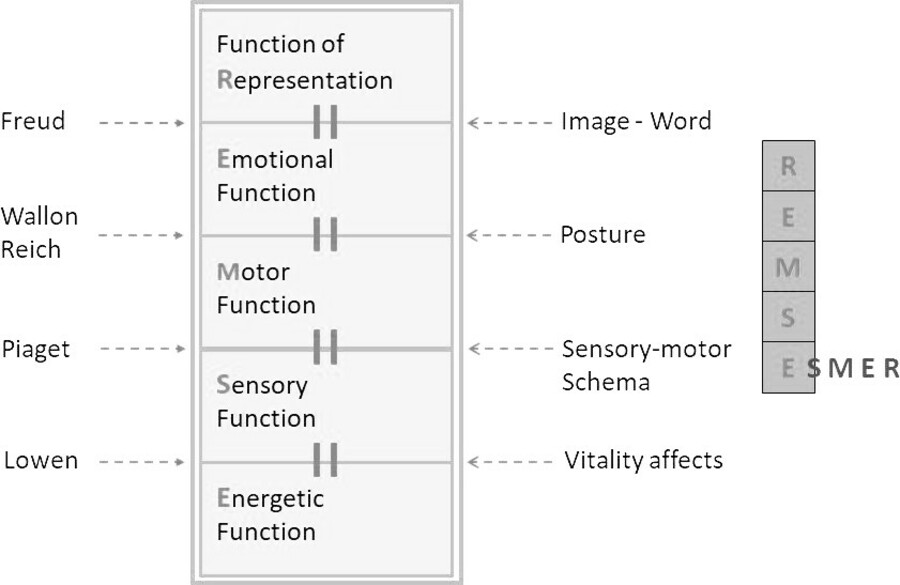
The Self and its Five Functions
This regulated force drives the human organism made up of billions of cells, drives its brain which is composed of billions of neurons, drives the spirit born from the interaction between those billions of cells and billions of neurons, drives the communities of human organisms that build culture.
A regulated metabolic dynamic, guided by homeostasis, would be the essential factor that typifies the origins of life, the essential process for the conservation of life and the generating principle of its creative dimension.
The Therapist – “Guardian” and “Regenerator” of the Force
Wilhelm Reich and later Alexander Lowen relentlessly traced the Force within us: it was called “bioenergy”, energy of the universe converted into biological energy. This life force became the fundamental subject matter of this wonderful therapeutic method developed by Lowen and that brings us here.
A bioenergetic therapist has, therefore, this first essential function: to help patients continuously renew their vitality, driven by the bioenergetic force. Because Lowen conveyed that paradigm: human complexity is only alive, loving and creative when it succeeds in preserving its energetic potential, when it manages to regenerate that life force that occasions it to act and interact.
To this end, the bioenergetic therapist uses a variety of exercises and “energetic” task situations that are the envy of many other Schools.
Two big functions organize this energy potential:
The expansion-contraction function: The flows of energy functionally run from the organism center towards its periphery, which is from the inside to the outside, creating expansion and supporting the adaptive action or the act of communication (Refer Figure 2). This is true at a cell level (from the nucleus to the membrane), and it is also true in terms of the organism as a whole (from the inside to the outside) (Reich, 1940). But muscle contraction can interrupt that flow, preventing it from reaching the periphery and inhibiting expressiveness and motor skills. Chronic muscle contraction then paralyzes expression and action.

The Direction of the Force from Centre to Periphery
The pulsating and wave function: The energy flow which runs from the center of the organism to its periphery is rhythmic: the alternating expansion and contraction produces pulsation (Refer Figure 3). These rhythmic pulsations drive all living beings, from the amoeba to human being (Reich, 1940). The segmental organization of vertebrates made the pulsating function more complex, to which a wave function was associated (Reich, 1940, p. 314). But when the pulsating/wavy movements are interrupted, movement is no longer generated: the energy, sensory and emotional states diminish considerably, until they can no longer be perceived.

The Pulsatile Function
The Therapist – Co-Regulator of the Life Force and of the Self
The bioenergetic therapist has this second essential function: to help patients find or recover their sense of homeostatic regulation. How does the therapist do this?
Firstly, through co-integrating the pendulous movement of opposing experiences (Refer Figure 4). At all levels of the Self, the life process swings like a pendulum between extremes (Lowen, 1958, p. 68; pp. 81–84): between inhalation and exhalation, between hyper-arousal and hypo-arousal of sensory functions, between muscle contraction and relaxation, between love and hate, between yes and no.

The Pendular Function
This pendulous movement has to learn to build bridges between the extremes, to co-integrate opposites and to find a halfway reference point between them, a centre through which the pendulous movement will not cease to pass throughout its continuous regulation … until it becomes the centre of the Self, the centre of gravity of a vertically aligned Self.
Porges’s Polyvagal Theory
Stephen Porges’s (2011) polyvagal theory suggests a new modelling of the post-traumatic Self entailing four different positions:
When it is in the area of optimal activation (refer Figure 5);
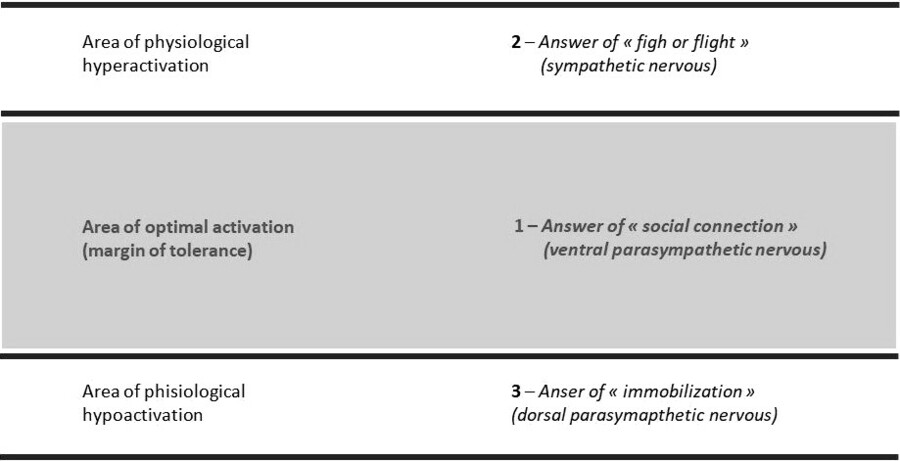
Polyvagal Theory: Optimal Activation
When it is trapped within the extreme polarity of chronic sympathetic hyper-arousal (refer Figure 6);

Chronic Sympathetic Hyper-arousal
When it is trapped within the extreme polarity of chronic dorsal parasympathetic hypo-arousal (refer Figure 7);
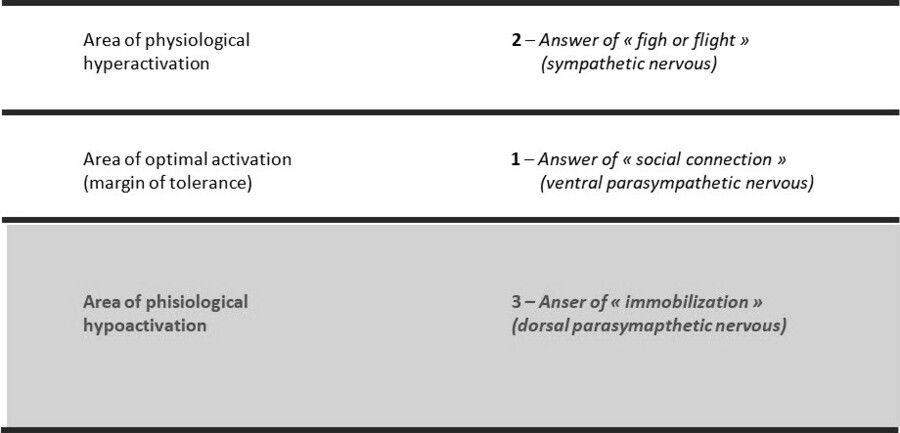
Chronic Sympathetic Hypo-arousal
When it is trapped in continuous shifts between one extreme and the other (Siegel, 1999) (refer Figure 8).

Continual Shift Between Hyper- and Hypo-arousal
Secondly, the therapist helps the patient find or recover their sense of homeostasis through the pendulous movement regulator of functional bipolarities. The therapeutic process is thus aimed at restoring the regulating “pendulous movement” within an optimal physiological arousal area of the organism: neither too much nor too little.
The functional bipolarity between an energy charge, which is handled by the upper half of the organism, and an energy discharge, which is handled by the lower half of the organism, the organism, ultimately, seeking its balance or “energy balance” (Lowen, 1972, p 55). The principle of “grounding” follows from this (Lowen, 1958, p. 79) (refer Figure 9).

The Grounding Position
The functional bipolarity between a sensory and tender expression handled by the anterior side of the organism and a motor and aggressive expression handled by the posterior side of the organism, the organism, ultimately, seeking balance and the union of them both (Lowen, 1958) (refer Figure 10).
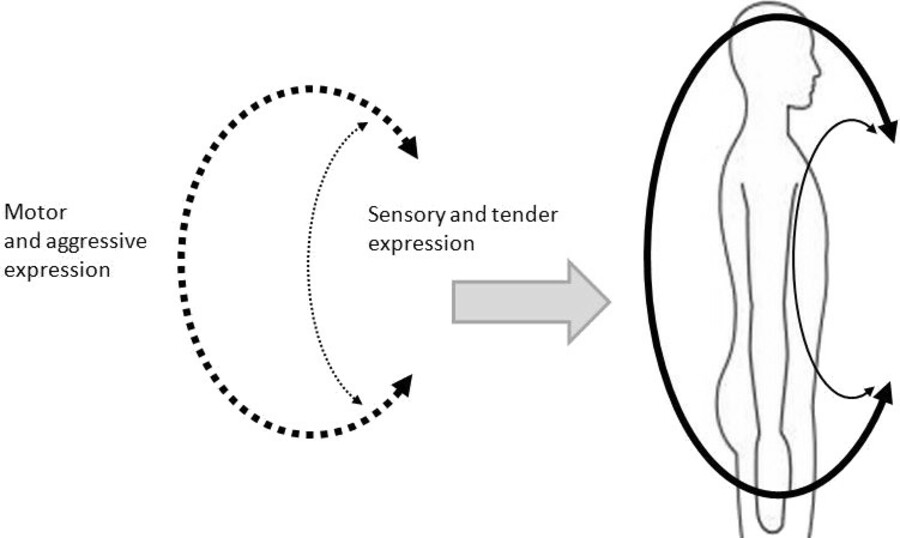
Bipolarity Between Anterior and Posterior Side of Organism
The functional bipolarity between intellectual and sublimation activities produced by ascending flows of physiological arousal and the motor and sexual activities produced by descending arousal flows, the organism, ultimately, seeking to balance and co-integrate these antithetical flows (refer Figure 11).
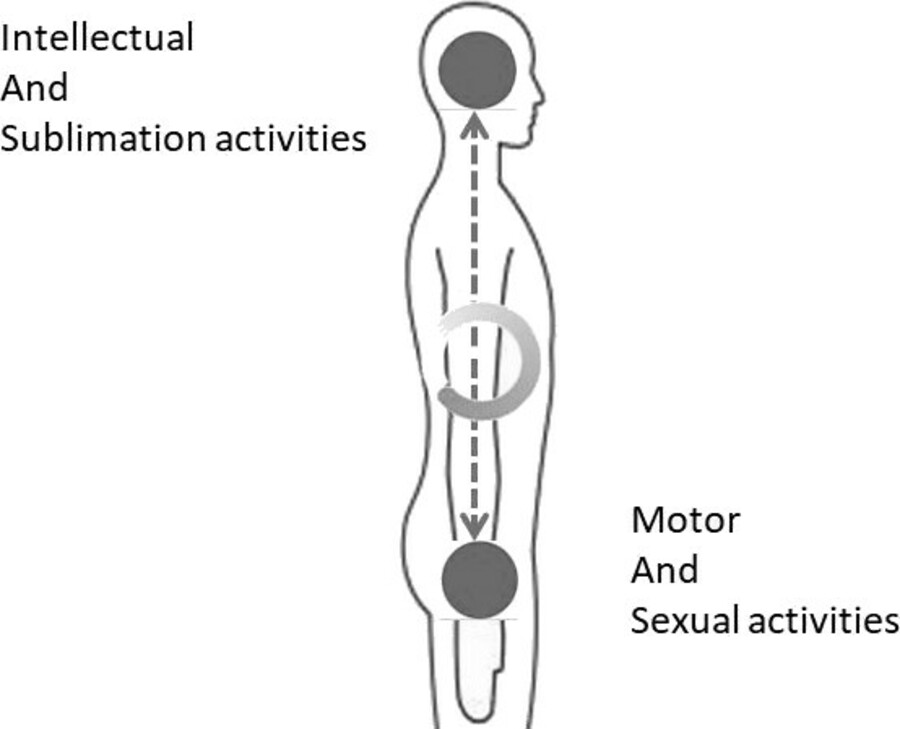
Bipolarity Between Upper and Lower Part of Organism
To respond to all these organismic regulations needs, there are numerous resource exercises initially created by Alexander Lowen and described in his publications, and which were later improved by successive generations. The most classical ones involve breathing exercises as well as the use of the respiratory stool, kicking, reaching out, grounding, the use of the racket, etc.
The Therapist – Transmitter of Relationship Regulating Properties
The human Self has also had to develop a regulated social relationship system. Humanity inherited relational and behavioral skills from the species that preceded us, particularly the large apes with which we share at least 95 per cent of our genome. The attachment bond that unites a large ape with its offspring or with the other congeners already possesses most of the properties on which the human attachment bond and, ultimately, any human social relationship is based.
We bioenergetic analysts have understood that these properties and values were first expressed, over the course of the millennia, in corporal and interactional modes that were assisted by an ever-increasing brain complexity (Damasio, 2017). Our limbic system bears an attachment instinct imprint, with a tendency to provide support and comfort; empathy is inscribed in brain nerve structures, especially in mirror neurons.
The bioenergetic therapist has this third essential function: to help patients discover, rediscover or develop the six properties of the attachment relationship that organize and regulate all future social relationships (Tonella, 2014):
Mutual intentionality: designates the conscious interpersonal determination to express one’s intentions and to interact with another/others. It is at the source of intersubjective relationship and of shared meaning (Trevarthen, 1979, 1998).
Mutual synchronization: designates the interpersonal effort aimed at synchronizing the rhythmic aspect of the exchanges: responding to another neither too early nor too late (Beebe, 2000). To this end, the physiological rhythm of the biological systems, such as the respiratory rhythm, and the behavioral relational rhythm, as for example the linguistic rhythm, must also be synchronized (Reite and Capitanio, 1985, p. 235).
Affective attunement: this is about adjusting to the partner’s emotional state, both in the non-verbal mode, through vocal, miming, postural, gestural, tactile micro-adjustments, as well as in the verbal mode (Stern, 1985). These echoes, resonances, affective vibration phenomena participate in the feeling of being “received” and “understood”.
Containment: containment offers, by definition, a contour that delimits and unites a fluctuating and unfocused content. The musculature and its tonicity variations constitute the prototype containing the arousal flows so that they can be metabolized and non-toxic: not be overwhelmed, without overwhelming the other either. The other, for example a therapist, may also play a containment role when appropriate, for example with his/her patient (Bion, 1977).
The regulation of vitality and sensory-emotional states: this involves maintaining internal homeostasis within a “physiological margin of tolerance” between the two extremes of hyper-arousal and hypo-arousal (Siegel, 1999). The arousal flows thus regulated can then be contained, tolerated and tuned towards psychic attention, for possible elaboration followed by action (Schore, 1994, 2003; Porges, 1997; Beebe and Lachmann, 2002).
Repair: in interpersonal relationships, repair follows a loss of attunement, a desynchronization, or a loss of containment or emotional self-regulation. This implies recognizing one’s own failure, transforming the negative feelings that it generates into positive feelings and re-establishing mutual intimate communication (Tronick, 1989). The ability to repair increases one’s vitality and one’s attachment skill (Greenspan, 1981, cited by Schore, 2003), as well as power of resilience (Demos, 1991).
These six properties enfold the germ of social values such as justice, ethics and peace, which are embodied in cultural, artistic, sports and scientific manifestations. This International Conference is a good example of this. In order to discover and develop each of these six properties, several interactive exercises have been created (Tonella, 2014) allowing to discover/develop each of these six properties.
The Therapist – “Ferryman” from Nature to Culture
To maintain its homeostasis, the living organism must be in close relationship with its natural environment. It has differentiated itself from Nature, and yet it is what it is made of. It belongs to nature. It consumes nature, but it has to restore it. Homeostasis of a biological nature is intrinsically linked to homeostasis of an ecological nature. It is from these successful regulations that emerged life, becoming then more and more complex. From nature is born the human being then the culture.
We are undoubtedly the only species that has developed a cultural dimension based on symbolization processes through signs, images or words. But we must admit that the species that preceded us within evolution groomed us to develop the processes and behaviors that promote culture as a cohesive factor of humanity.
We are therefore, once again, bioenergetic therapists, drivers and choreographs of a vital dance in which instincts inherited from the need for constant adaptation to the natural environment consort with the desire to belong to a culture that molded us from birth and continues to stimulate our desires. Upon reaching adulthood, at best, we experience a state of harmony between the need for nature and the desire for culture, and on occasion contradictions and conflicts caused by fissures between instinct and desires, between nature and culture.
The bioenergetic therapist has this fourth function, equally essential: we are repairers of bonds between nature and culture, because, when working with the body, we discover lost or dormant instincts or millenary sensations, inhibited by everyday tensions, stress, the quest for performance or for one’s social image. In therapy, we awaken sensory-emotional constellations that, in one’s breathing, recall the wind and, through movement, evoke dancing in the wind. Bioenergetic analysis engages in a constant dialogue between immemorial corporeal flows and emerging cultural models. Let us never forget those principles and techniques that Alexander Lowen taught us since the 1960s, founders of a practice of one thousand-year-old body intelligence.
This is how the work of bioenergetics makes us swing between being anchored to the mainland (the “grounding” of Lowen, 1958) and the “oceanic feeling” of belonging to the universe as a whole. We are rock and we are wind. We are atomic matter and we are vagabond spirits. The bioenergetic experience weaves that continuum between the atom and the spirit, that dizzying complexity from which restoration, creation, love and beauty arise. It has that extraordinary power to lend life to the union between the infinitely small and the infinitely large, between the feeling of humility and the feeling of exaltation.
If our own bioenergetic therapy has been able to germinate these different levels of consciousness within us, then we will pass them on to our patients. We will transmit bonds of attachment that unite us both to humanity and to nature: the nature of these bonds is sensori-emotional, and they are intrinsically intelligent and deeply regulating.
The Therapist – Promotor of Life Force, Love and Attachment
The bioenergetic therapist has, finally, this fifth imprescriptible function: that of working in the human dignity dimension and promote it. We try to seed love in the hearts of our hurt, unloved, mistreated, abused patients: love of self and love for others. “Without love … we are nothing,” sang Edith Piaf. Love makes us beautiful and clairvoyant: the beauty of flowers, of a starry sky, of the sound of the waves, the murmur of the leaves in the trees … Love cares: it takes care of oneself, of others, of nature.
I believe that love, like empathy, like taking care of another and of nature is not a simple psychic construction or a mental awareness. It is above all a state of being, sensory and emotional, that dwells deeply within us and is handed on to us through the process of attachment by our mother: our biological mother as well as mother Nature. A multitude of age-less sensory-emotional constellations stem from this maternal conjunction, born from stardust converted into atoms, cells, heart, womb, brain, implicit memory, and arms outstretched to another.
The bioenergetic therapist, due to his/her humanity and universal presence, returns to the patient’s physical consciousness those sensory and emotional states matrices of life. When an organism beats, vibrates, recovers its light, millions of photons are expelled which in turn illuminate others, going through concentric layers, from the nearest in which his loved ones reside, to the farthest, where the absent reside.
As bioenergetic analysts, we have an implicit commitment: to transmit the memory of the universe turned into Nature on earth because it is engraved in our physical-chemical properties, in our vital pulsations, in our corporal rhythms, and in our attachment interactions with the members of our own species, of other species, with the trees, the flowers, mountains and rivers. Perhaps we have that particular mission of transforming that implicit memory into an explicit memory because our tool is our body and our purpose is the awakening of those sensory-emotional constellations becoming self-consciousness, the consciousness of humanity, the consciousness of Nature in which it is immersed and is its cradle. Happiness is in that preserved Beauty that blooms within oneself and around oneself.
Bioenergetic analysts are only “ferrymen” on multiple levels. We conduct from the macro-system, which creates the universal feeling of infinite beauty, up to the micro-system, which creates the intimate sensation of cellular pulsation. We are “ferrymen” from the atom to the spirit, from cellular reality to self-consciousness. We are “ferrymen” from belonging to Nature up to inscription in Culture. We can also be, in these troubled times, regenerators of individual and collective consciousness.
We are the energy of the stars converted into human matter and bodily intelligence. We are the spirit of the universe placed by the wind in a dance, in a poem, in a song. Listen to this song how beautiful it is! (Casta Diva from Vincenzo Bellini’s opera Norma, sung by Filippa Giordano).
This voice invites us to spirituality, doesn’t it? But where is the spirit? Quantum physics teaches us that it is in each one of our atoms and in each of the atoms of the universe; it is beyond time and space, everywhere at once. The spirit cannot be located. It is quanta, it is a property of this vast ecological system that is the universe to which we belong. The spirit is star, mankind and wind.
May the force be with you!
References
Beebe, B. (2000). Co-constructing mother-infant distress: The micro-synchrony of maternal impingement and infant avoidance in the face-to-face encounter. Psychoanalytic inquiry, 20.
Beebe, B. & Lachmann, F. M. (2002). Infant research and adult treatment. Hillsdale, NJ: Analytic Press.
Bion, W. (1977). Seven Servants. New York: Jason Aronson.
Damasio, A. (2018). The Strange Order of Things: Life, feeling, and the making of Cultures. New York: Pantheon Books.
Demos, V. (1991). Resiliency in Infancy. In T. F. Dugan and R. Coles (Eds.), The child in our times: Studies in the development of resiliency (pp. 3–22). New York: Brunner/Mazel.
Lowen, A. (1958). The Language of the Body. New York: Grusse and Stratton.
Lowen, A. (1972). Depression and the Body. New York: Coward, McCann and Geoghegan.
Porges, S. (1997). Emotion: An evolutionary by-product of the neural regulation of the autonomic nervous system. In C. S. Carter, I. I. Lederhendler & B. Kirkpatrick (Eds.), The Integrative Neurobiology of Affiliation (pp. 62–78). (Annals of the New York Academy of Sciences, Vol. 807). New York: New York Academy of Sciences.
Porges, S. (2011). The polyvagal theory. New York, London: W. W. Norton and Company.
Reich, W. (1940). The Function of the Orgasm. New York: Orgone Institute Press.
Reich, W. (1972). Character Analysis. New York: Farrar, Straus and Giroux. First published as Charakteranalyse (1933).
Reite, M. & Capitanio, J. P. (1985). On the nature of social separation and attachment. In M. Reite & T. Field (Eds.), The Psychobiology of Attachment and Separation (pp. 223–255); Orlando, FL: Academic Press.
Schore, A. (1994). Affect Regulation and the Origin of the Self: The Neurobiology of Emotional Development. Hillsdale, NJ: Erlbaum.
Schore, A. (2003). Affect Regulation and the Repair of the Self. New York: W. W. Norton.
Siegal, D. (1999). The Developing Mind. New York: Guilford Press.
Stern, D. (1985). Le monde interpersonnel du nourrisson. Paris: PUF.
Tonella, G. (2008). Paradigms for Bioenergetic Analysis at the dawn of the 21st Century. Bioenergetic Analysis, The Clinical Journal of the IIBA, 18, 27–59.
Tonella, G. (2014). As propiedades reguladoras da relaçao interpessoal. Revista Latino-Americana de Psicologia Corporal, 2(1), 8–2.
Trevarthen, C. (1979). Communication and cooperation in early infancy. A description of primary intersubjectivity. In M. Bullowa (Ed.), Before Speech: The Beginning of Human Communication (pp. 321–347). London: Cambridge University Press.
Trevarthen, C. (1998). The concept and foundations of infant intersubjectivity. In S. Braten (Ed.), Intersubjective Communication and Emotion in Early Ontogeny (pp. 15–46). Cambridge: Cambridge University Press.
Tronick, E. (1989). Emotions and emotional communication in infants. American Psychologists, 44, 112–119.
About the Author
Dr Guy Tonella is a Doctor in Clinical Psychology, CES of Psycho-physiology, Certified Bioenergetic Therapist, Co-Director of the Collège Français d’Analyse Bioénergétique, Member of the IIBA Faculty. He was Professor of Psychology at Toulouse University for 20 years. He teaches in most European countries and in Argentina, Brazil, Canada, China and New Zealand. He is in private practice in Toulouse in France.
Footnote
- [1]
- Keynote Address delivered to the 25th IIBA Conference in Portugal, 25 May 2019.